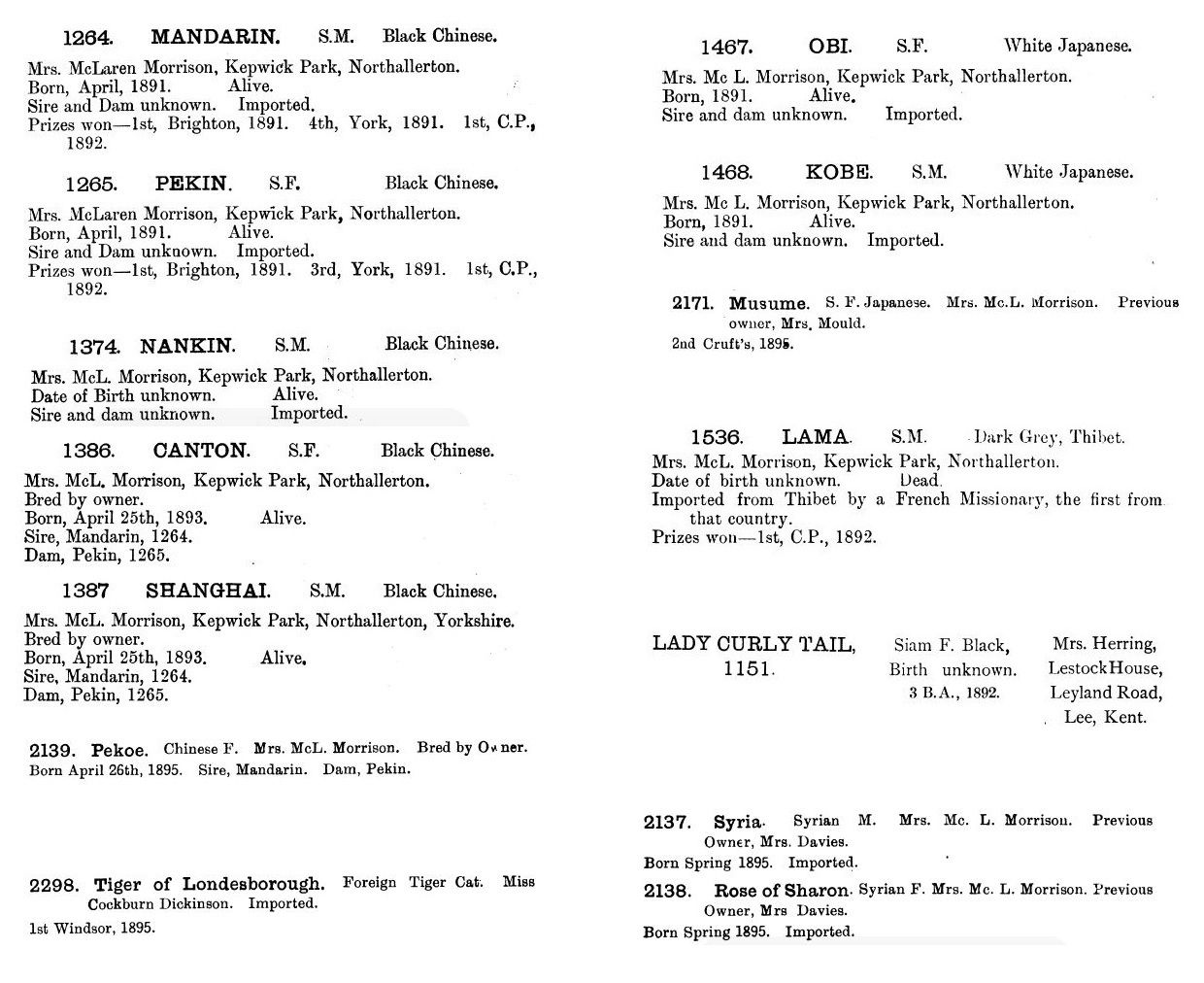
EARLY FOREIGN AND ORIENTAL CATS NON-COLOURPOINTED KIN OF THE SIAMESE
Most cat lovers are familiar with Siamese cats, which are one of several native breeds originating from Thailand. Siamese cats have pale bodies and coloured limbs, tail, face and ears. Because the early Siamese breed club did not permit non-pointed "Siamese" cats, these were known by a variety of names including Burmese and Chinese. Some of the early reports are frustratingly vague were the self-brown cats really solid coloured or were they Burmese-pattern i.e. low-contrast pointed pattern? Which of the chocolate Siamese were solid colour and which were pointed?
In spite of the vague descriptions, there is evidence that non-pointed Siamese (in the conformation that prevailed at the time) date back to the infancy of the cat fancy, almost a century before they were gathered together under the "Oriental" name. Some were registered and recognised as Siamese, as can be seen from early studbooks.
EARLY BEGINNINGS IN BRITAIN
In 1892, Mrs Herring had a female Black Siamese named "Lady Curly Tail." In later publications she was referred to as Siamese, with no reference to her colour.
Mrs McLaren Morrison of Kepwick Park imported a pair of "Black Chinese" shorthairs and bred several offspring from them. The parents, Mandarin and Pekin, both won prizes in 1891 at Brighton and York. The Sketch, of June 10, 1896 tells us "It is at Kepwick Park that Mrs. Mclaren Morrison has [...] some Chinese cats with their long, wedge-shaped heads, bright golden eyes and shiny, short-haired black fur," i.e. Foreign Blacks.

The "Swiss Mountain Cat" mentioned in Frances Simpson's "Book of the Cat" and several other publications have been claimed as early examples of several breeds and the description brings to mind Chocolate (US Chestnut) Foreign Shorthairs. According to Simpson: "The best and most definitely coloured AOC I ever saw was Mrs Davies' Sin Li,' a deep self-coloured chocolate-brown cat. He was supposed to be one of three Swiss mountain cats imported to this country." According to Harmsworth London Magazine of 1900, "Mrs. Sutherland, who lives among the Alps, has bred some beautiful chocolate Siamese cats." Descriptions are infuriatingly vague. They might have been solid colour "Siamese" or might have had the Burmese pattern, however all sources agree that they were Siamese in conformation.
Master Timkey Brown and his dam, Granny Grumps owned by Mrs French and described as "Siamese with coats of burnished chestnut with greeny-blue eyes." Fur and Feather described Granny Grumps as "an all-brown Siamese with yellowish eyes. Her true value was realised by Mrs French, but Granny was denounced as a freak and not right', long before any interest could be aroused. " her son, Master Timkey Brown, had been neutered. The self-brown Siamese was abandoned after the 1920s following a statement from the Siamese Cat Club of Britain that "The club much regrets it is unable to encourage the breeding of any but blue-eyed Siamese."
A "copper coloured" Siamese cat is mentioned in the article "Mrs. Brassey at Home," [Normanhurst Court, Catsfield, Sussex] in the Hastings and St Leonards Observer of 22nd May, 1880. "My hostess [has] a copper coloured Siamese cat in [the] gardener's cottage be visited." Mrs. (Lady) Brassey died of malaria in 1887 and nothing further was heard of her copper coloured Siamese.
Harrison Weir wrote in "Our Cats" (1889) "Mr. Young of Harrogate possesses a chocolate variety of this Royal Siamese cat; it was sent from Singapore to Mr. Brennand." Again details are vague as this may have had the Burmese pattern, but it carried the colourpoint gene as it produced pointed offspring when bred to a Royal Siamese. According to Miss Forestier Walker (Book of the Cat, 1903) and several of her contemporaries the chocolate Siamese either had what we now consider the Burmese pattern or the Tonkinese pattern, but with blue eyes. Nevertheless, they had the conformation of the Siamese cats of the time.
There are photos of many of these early "Siamese" cats at Shorthaired Cats Of The 19th Century - Swiss Mountain Cat (And Chocolate Siamese)
It the chocolate Siamese of the past are more like the modern European Burmese, then this "Burmese" cat, which appeared in this photograph in Frances Simpson's 1903 "Book of the Cat", appears to be more like an Oriental ticked tabby.
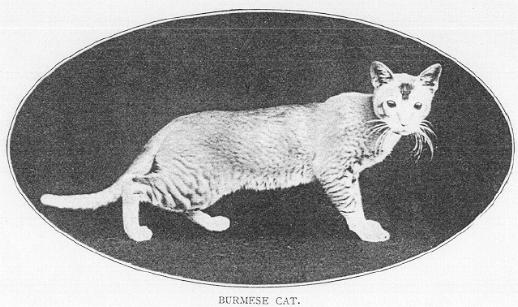
In Frances Simpson's "The Book of the Cat" (1903), Mrs Constance Carew-Cox described her Blue Siamese: "In 1889, however, I purchased a smooth blue, whose owners declared her to be a Siamese - she certainly resembled a puma-shaped Siamese in her body outline and movements - and I believe I entered her in the stud books as such. 'Dwina' won many prizes at Crystal Palace and other shows in 'Any Variety' classes, was a most faithful creature, reared many families, and lived until June 1901." A male "Blue Siamese" was exhibited at Holland House, London during the summer of 1896. The National Cat Club registered it as "Nam Noi" of unknown parentage imported by Mrs B Spearman in January 1895. He was exhibited as a Siamese and was "Siamese in every detail, shape, tail and eyes. .." but was disqualified for not being a seal-point. Due to the vagaries of the cat fancy, this blue variety from Thailand was eventually recognised as the Korat rather than a Foreign Blue Shorthair, something that saved it from being bred for extreme conformation.
In the American "Cats" magazine in November 1972, Angela Sayer wrote the following about brown Siamese cats and mentioned Granny Grumps and Master Timkey Brown. "Self-colored brown cats have appeared from time to time throughout cat history: [. . .] Cats of this variety were acclaimed on the Continent and even had classes provided for them at some shows but fanciers in England were not sufficiently impressed to start breeding them seriously. At this stage these cats were called Self Chocolate Siamese, and it was not until the 1920's that several British Fanciers took up the breed once more and, in 1923, a Sister Stockey imported a Self Chocolate called Adastra, believed to be the ancestor of a great many of our present-day Chocolate-point Siamese. A great confusion existed in the early days of the cat fancy between the self brown that is genetically a self-colored Chocolate-point Siamese, and the brown Burmese/Siamese hybrids or 'Tonkinese.' This accounts for the many and very varied accounts of brown cats and their varying descriptions. Chestnut Browns are born brown, but the Burmese and Burmese/Siamese hybrids are born cream or beige, the hybrids later develop slight points. If the two types were indiscriminately mated together, as they doubtless were, by breeders with little or no genetic knowledge, the results would have been most disappointing for them, with predominately Siamese and Black kittens turning up and virtually no self browns at all. These breeders would then have felt that the 'brown' cat was, after all, only a sport, and would then have abandoned their breeding programs and concentrated on easier breeds such as Siamese."
Another early brown self-coloured "Siamese" was imported into England by Mary Russell, Duchess of Bedford. Bogie was a dark brown self-coloured cat and Louis Wain described it as "A whole-colour, very dark-brown cat, is likewise a Siamese." Though again we can't rule out the Burmese-pattern.
"Cat Gossip," of September 28, 1927, in a column called "Siamese and Their Owners" "Mrs. Croucher, who lived for some time in the Far East came the following interesting notes: There are no true black Siamese; there are chocolate Siamese, dark brown with blue eyes; I brought one of them, as a kitten, back with me from Siam, but he died last Autumn. Then there is the Siamese cat which we breed here, light fawn with blue eyes and there is a brown Siamese with yellow eyes. [. . .] " though again this indicates the Burmese "seal" (sable) colour. The Editor, H.C. Brooke, noted " Can anyone tell me why an ordinary pair of Siamese cats can produce a jet black cat with golden eyes; two such specimens have been born in England; one of them I have seen, and there was no mesalliance' in the case of either."
Cat Gossip 9 January 1929 has this very brief mention of a self-brown foreign cat: "We deeply regretted to learn that Mrs. French's "Cigar-coloured" Siamese kits are dead."
Cat Gossip October 16 1929 - Mr. H. D. Bassett writes: "My experience, extending over seven years, has proved one very extraordinary thing. In about every fifth generation there will be found a black kitten, and in every case it is a male. I have never known this to fail. Coal black from top to tip, with eyes of a deep golden colour, not yellow, but more of the orange colour. [. . .] Only one (black) have I been able to raise, and unfortunately he was killed after fathering two litters of kittens." Unfortunately Mr. Bassett said nothing about Black Siamese cat's offspring.
Another account mentions black Siamese being born to a pair of seal points, though the fact that the black kittens were larger suggests the mother also consorted with a black cat. "It is over ten years ago when Yolanda, at six years, was mated to Mrs. Robinson's Bigabois, the result being six kittens, one white as usual and a female, the others, all males, being black. Unaware that Black Siamese could be correct, I destroyed four; the remaining black reached maturity, possessing real golden eyes." Unfortunately a superstitious local shot the Black Siamese. The breeder mated Yolanda again, but no more black offspring appeared, either from Bigabois or other studs which strongly suggest Yolanda had mis-mated. Yolanda's grand-daughter, Goona was mated to seal point Vichnou and produced three white and one, larger, black kitten. The owner wondered if there were any other owners or breeders in England "who have had any of these precious black Siamese. If all goes well I hope to exhibit the kitten with his mother at Croydon in November."
So it is confirmed that Foreign (or what is now called Oriental) cats existed as far back as those early days. They were Siamese in all respects apart from colour. Because the Siamese had not been bred for extreme conformation these early Foreigns did not resemble the cats we now call Orientals, but would be closer to the Maew Boran, the Natural Cat, that continues to exist in Thailand.
DEVELOPMENT OF "FOREIGN SHORTHAIRS OF SIAMESE TYPE" IN BRITAIN AND EUROPE
There were white Siamese bred in France during the late 1920 and early 1930s.
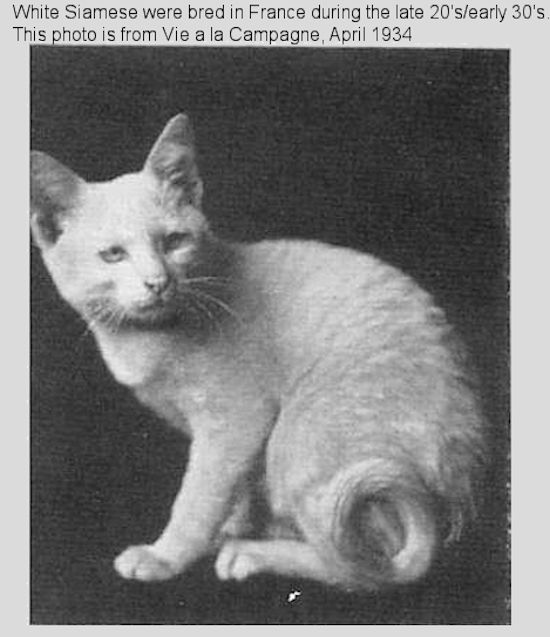
The post-war Russian Blues were very Foreign in type due to crossing them with Siamese during wartime when breeding stock was scarce. Hence the Russian Blues use to create the Havana were closer in type to Foreign Blues than to modern Russian Blues. Early in 1948, Mrs A. Hargreaves decided to carry out some breeding experiments to improve the Siamese breed's stamina and disease resistance. She needed to outcross to a cat that didn't introduce unwanted traits so she chose the Foreign-looking post-war Russian Blue. She mated Siamese queen "Laurentide Ludo" to "Silvershoen Blue Peter," unaware that this would eventually lead first to the Havana (Foreign Chestnut Brown) and then to a whole new breed-group for self-coloured cats - both shorthair and longhair - of Siamese cats.
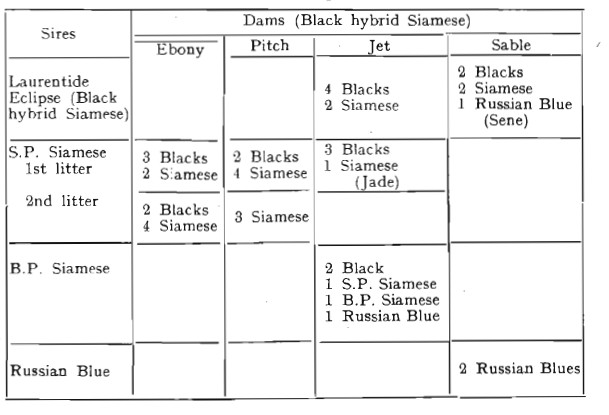
The family tree is best viewed on a separate tab using your browser's magnifier.
In 1951, two breeders, Baroness Edit von Ullmann (Roofspringer Cattery) and Mrs A Hargreaves (Laurentide Cattery) began to develop self-brown cats with Foreign conformation. In 1952 von Ullmann mated a black domestic shorthair (Maximilla Unterkatze) to a Chocolate Point Siamese called "Susharo." Meanwhile, the first ever Havana was Mrs Munro Smith's "Elmtower Bronze Idol." Mrs Smith's black shorthair, "Susanah" (the offspring of Seal Point Siamese female "Tsiu Chow and a black domestic longhair, "Pickles") was mated to Seal Point male "Tombee" and produced a litter of four kittens, including a brown-coloured male ("Elmtower Bronze Idol") in May 1952 and a repeat mating produced the female "Elmtower Bronze Study." Elmtower Bronze Idol was mated to one of von Ullman's chocolate-carrier Roofspringer females resulting in "Roofspringer Muscatel" (male) and "Roofspringer Shandy" (female) in 1953. "Roofspringer Muscatel" sired "Roofspringer Mahogany" who was later exported to America.
Mrs Hargreaves mated a Seal Point Siamese, "Laurentide Ludo," to a Russian Blue, "Silvershoen Blue Peter," resulting in a shorthaired black female called "Laurentide Ephone Jet." Jet was mated to a Chocolate Point male, "Briarry Saccharin" and some of the "British Black" and "Russian Blue" offspring went to Baroness von Ullman and Mrs Elsie Fisher. Mrs Fisher's black female was mated to a Russian Blue and produced a Havana male named "Praha Gypka." Then Mrs Hargreaves' blue female was mated to her sire, Briarry Sacharin and also produced a Havana male, "Laurentide Brown Prior". Mrs Joan Judd (Crossways) was interested in the breed, but was not happy with conformation of the Elmtower cats. She mated her Seal Point Female with Fisher's "Praha Gypka" to produce "Crossways Velvet Toy" in 1955.
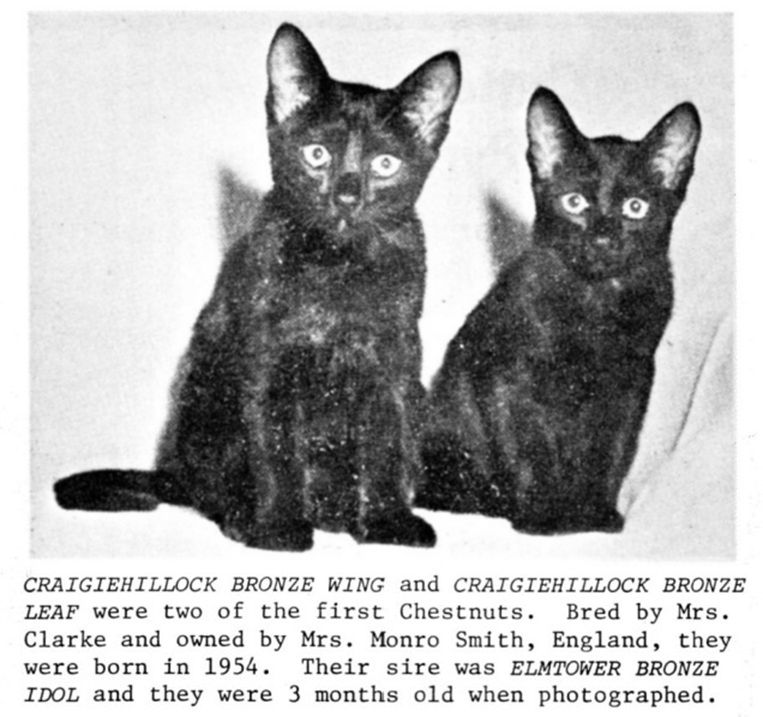
Elmtower Bronze Idol, Elmtower Bronze Study, Praha Gypka and Laurentide Brown Prior became the founders of the new Havana (or "Self Seal") breed. In 1958 the Havana was recognised by the GCCF as the Chestnut Brown Foreign. Because the original Havanas were somewhat cobby, those exported to the USA were developed into the Havana Brown breed, while the British Havanas were known there as Foreign Chestnut (now called Chestnut Oriental). In 1970, the GCCF allowed the British breed to be renamed "Havana." The American Havana Brown has since been developed into a quite different-looking cat, while the British version remained an Oriental cat.
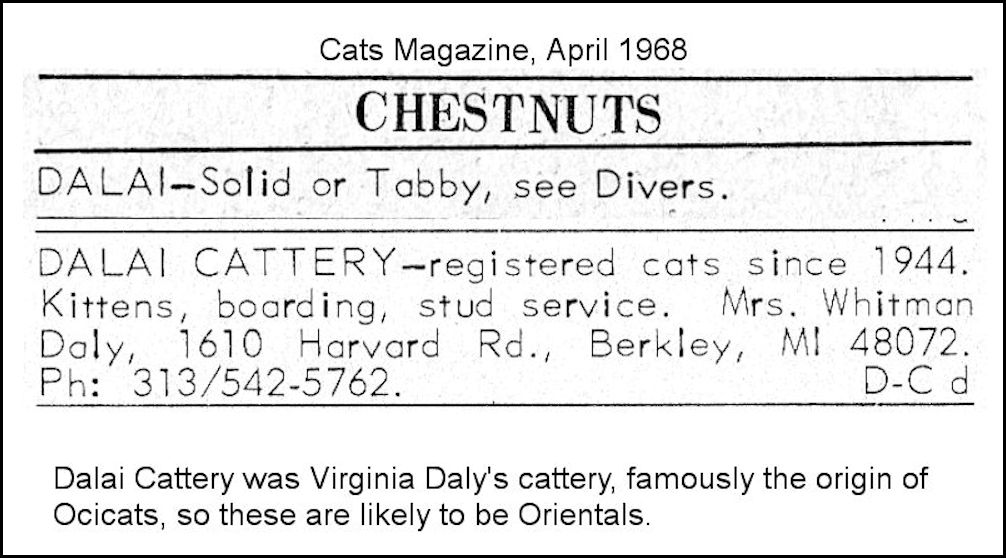
The original American importers of Havanas in the 1950s were Laurentide Brown Pilgrim imported by Mrs Jasmine Peters (Norwood Cattery) and Roofspringer Mahogany imported by Mrs Elsie Quinn (Quinn's Cattery) both of El Monte, California. They knew little of the breed origins prior to the cats bred by von Ullman, Hargreaves and Munro Smith to produce solid brown cats comparable to the Swiss Mountain Cat, and less highly strung than the Siamese. The American importers described their imported Havanas as comparatively small with a muscular, medium-long body and a sleek, glossy, coat of warm brown with rich highlights. The head tapered to a fine muzzle with a slight break behind the brown whiskers and a distinct "stop" at the oval, chartreuse-coloured eyes. American breeders founded unrelated lines using Russian Blues crossed to Chocolate Point Siamese (as "old-fashioned" type as possible) and backcrossing to a chocolate point to eliminate carriers of the colourpoint gene. Meanwhile, the British and European cats were bred back to Siamese (because of inbreeding) and their standard made no mention of a "stop" and required a long whippy tail.
Early terminology in Havana breeding can be confusing. Breeders used the term "blue" (in inverted commas) when they meant "dilution" (known at the time as "the character for blue" or "blue dilution.") Blue offspring can only be produced from black + dilution gene. The "blue" cats produced by Havanas (genetically chocolate) were actually lilac (lavender), but that colour was only recognised in Siamese and Foreign/Orientals at the time. To be clear to the modern reader reviewing old articles, Havanas did not carry blue, they carried what is now called "dilute".

In America, inbreeding from British imports had brought out a genetic abnormality split foot - a dominant gene with variable expression (i.e. not all cats with the gene exhibited the trait). This brought the breeding of the cats in Britain to a virtual standstill because not all breeders were willing to test-mate their cats to eliminate those with the faulty gene. Breeding didn't pick up again until the self-brown "Scintilla Copper Beech" popped up in Patricia Turner's Foreign White breeding programme. This cat traced back to Laurentide Ludo x Silvershoen Blue Peter on both her sire and dam's side. She was mated to lilac-point Siamese and should have re-established the Havana in in Britain, but the lack of pure Havana stock meant they were bred with Siamese and Orientals rather than being pursued as a separate breed.
In the 1990s, the International Havana Brown Society studied the pedigrees of Havana Brown cats and encountered a line of Havana Browns where both front feet were had white mitt, and some of these also had a white blaze, chevron or locket on the chest. The study identified three cats with common ancestry, all offspring of solid brown cats. They dubbed these "Bir-Havs" because the white mitts and chest marking were typical of Birman cats. White front toes have cropped up periodically in the Siamese breed, though they are rarely seen nowadays. Because Havana Browns were mostly derived from Siamese and Oriental Shorthairs in the 1950s, it's likely that there is an autosomal recessive gene for "white gloves." This may be linked to the white blaze. White gloves are also found in Birman cats, which were largely developed in France using Siamese cats, some of which had white toes. (Dominant White, Dominant White Spotting and recessive Birman White Gloves are alleles of the KIT gene (the order of dominance is White Masking >> White Spotting >> No White Markings >> Birman White Gloves). A cat with two copies of wg has gloved white feet and this trait has been fixed in some breeds e.g. Birman. There are hypothetical genes for other white mitted patterns.)
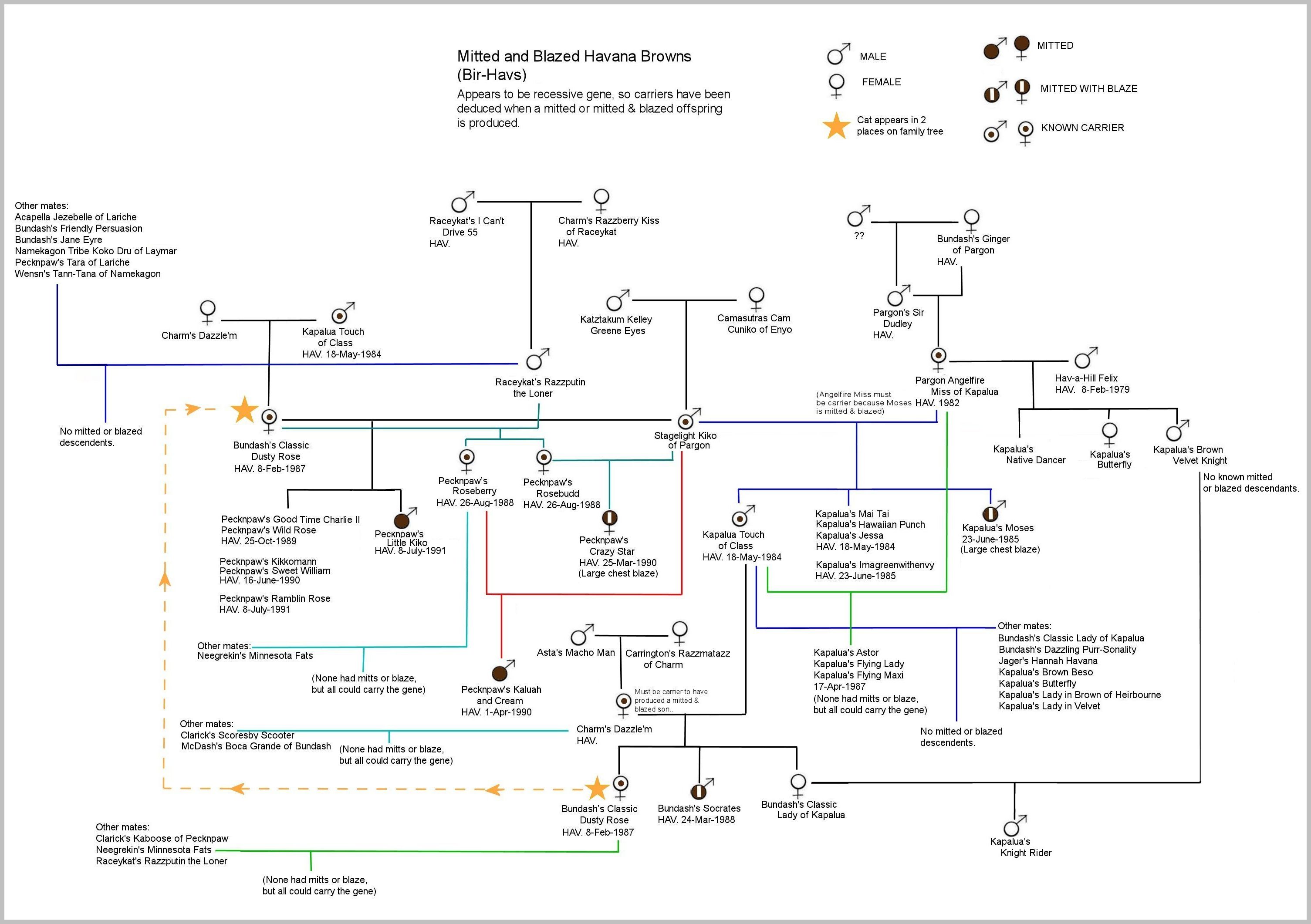
The white chest blaze, locket or chevron which is also associated with the gloves in the Bir-Havs may also be the result of this gene. A breeding between CH Angel fire Miss and CH Kiko produced Moses and a breeding between CH Kiko and CH Rosebudd (offspring of GC Razzputin the Loner and GC Classic Dusty Rose, DM) produced Crazy Star. Both cats had a white chevron from shoulder to shoulder without white gloves. On the other hand, all the known Bir-Havs had lockets or blazes in addition to gloves. Whether the white blaze is associated with the "gloves" gene, whether it is the result of another gene which is closely linked, or whether there is another modifying factor responsible can not be stated for certain. Stagelight Kiko was bred to 6 queens and produced mitted Bir-Havs when bred to Bundash's Classic Dusty Rose and Pecknpaw's Roseberry, and two blazed cats when bred to Pecknpaw's Rosebudd and Angelfire Miss. It is unlikely that Raceykat's Razzputin the Loner carried the white glove gene as none of his known direct offspring have had white toes or chest blazes.
Fast forward to the 21st Century when the Suffolk Chocolate and Suffolk Lilac (recognised in 2014 by the UK's GCCF) was developed because the British Havana (Chocolate/Chestnut Oriental) had become too extreme in type. By crossing to American-style Havana Browns from France, the original style of Havana was re-created, but since the name was already taken, the GCCF required them to have a new name. Because the dilution gene was present in both the UK Havana and US Havana Brown gene pools, Suffolk Lilacs (= Lavender in North America) naturally occurred.
In the mid 20th century, cat geneticist Patricia Turner saw an overdeveloped photograph of a lilac point Siamese and was inspired to develop a blue-eyed solid white cat with Siamese conformation. Careful breeding ensured the cats had "foreign blue eyes" and did not suffer from deafness. On 5th November, 1962, cat breeders in England started a "Foreign White" breeding program using dominant white British shorthaired cats and seal pointed Siamese as foundation cats. Dominant white masks all other colours. In 1967 a Chestnut Brown Foreign kitten named "Scintilla Copper Beech" was produced in her Foreign White breeding programme from mating Foreign White female "Scintilla Chu Pao" to a Lilac Point Siamese male, "Scintilla Croesus." "Copper Beech" became very influential in the Foreign/Oriental breeding programme.
In Ireland, a separate breeding programme for Foreign White was started at the same time. Red point Siamese were crossed with white British shorthairs. Unfortunately these cats inherited a number of defects including Waardenburg Syndrome, sterility and several health problems. Waardenburg Syndrome is due to an incomplete dominant gene that causes an unusual pattern of white markings, blue eyes that lack a tapetum lucidum in the eyes and deafness. Although the blue eyes and deafness were no worse than the same issues caused by dominant white, they were not desirable in Foreign Whites. It seemed that mating genetically red, cream, apricot or tortie point Siamese to Foreign Whites was linked to Waardenburg Syndrome.
In England in the late 1960's, Siamese breeder Maureen Silson wanted to produce a white Siamese. She followed the same process that had created white Guinea pigs i.e. breed a red to a Himalayan pattern. She used red (i.e. cinnamon) Abyssinian "Tranby Red Tutankhamen" bred to seal point Siamese female, "Annelida Fair Maid." This gave a chocolate agouti "Kernow Gerza" and a black agouti "Kernow Koptos". Silson bred these litter mates and produced "Southview Pavane" in May 1971. Pavane was registered as a Havana (i.e. self chocolate) but was actually a Foreign Cinnamon. Silson referred to Pavane as a "milk chocolate Havana," but when Pavane matured she was obviously not a Havana! For a while, cinnamon was called pavane in England. Silson continued to breed these cats and found that cinnamon was a recessive allele of black. This breeding programme also produced longhaired foreign type cats that traced back to Kernow Gerza and Kernow Koptos and these cats are the ancestors of most British Oriental Longhairs. Silson continued with her programme to breed white Siamese i.e. Foreign Whites.
Silson's "Tranby Red Tutankhamen" was the litter brother of "Tranby Red Sothis" who gave rise to Mrs Falkena-Rohrle's Cinnamon Orientals. Silson's "Southview Unacassiopeia," her son "Southview Duakylin" and daughter "Southview Duaebony" led to another line of Havanas.
In The Netherlands two separate Foreign White breeding lines were established. Both used orange-eyed white cats and Siamese. These programs started in the 1970s after the first difficulties had already been overcome by British and Irish breeders. Klaas van der Wijk (cattery Benvenida) started the first Dutch line of Foreign Whites.
Alongside the chocolate brown cats bred in the 1950's, Foreign Blues and Foreign Lavenders (Lilacs) were produced. Mrs Hargreaves developed a line of Lavender Self Shorthairs. By 1970, Angela Sayer had founded the "Foreign Lavender Group" and the Foreign Lilac (now the Lilac Oriental) was recognised in 1977. Pat Turner's Foreign White also gained Championship Status in 1977. Meanwhile, in the mid 1970's, Pat Turner had acquired a pair of Siamese x Chinchilla cats, "Scinta Celeste" and "Scintasilva Sue" and began to breed Smokes, Silver Tabbies and Pastels (now called Shaded) in order to study whether chinchilla was an allele of colourpoint as most geneticists believed at the time. This also controversially introduced tabbies into the mix.
As new colours and patterns were produced they were called "Foreign Shorthairs of Siamese Type" before the breed name "Oriental" was adopted. Early on, the self-colour cats were referred to as "Foreign" while the patterned cats were "Oriental." Nowadays, the Havana is conserved the first Oriental. Later on, all of these varieties, both self and patterned, would be pulled together into the Oriental breed group by America's CFA and most other registries would adopt that terminology to avoid confusion. Older paper pedigrees will describe the cats by the old breed nomenclature, but online databases have tended to rename them retrospectively for consistency.
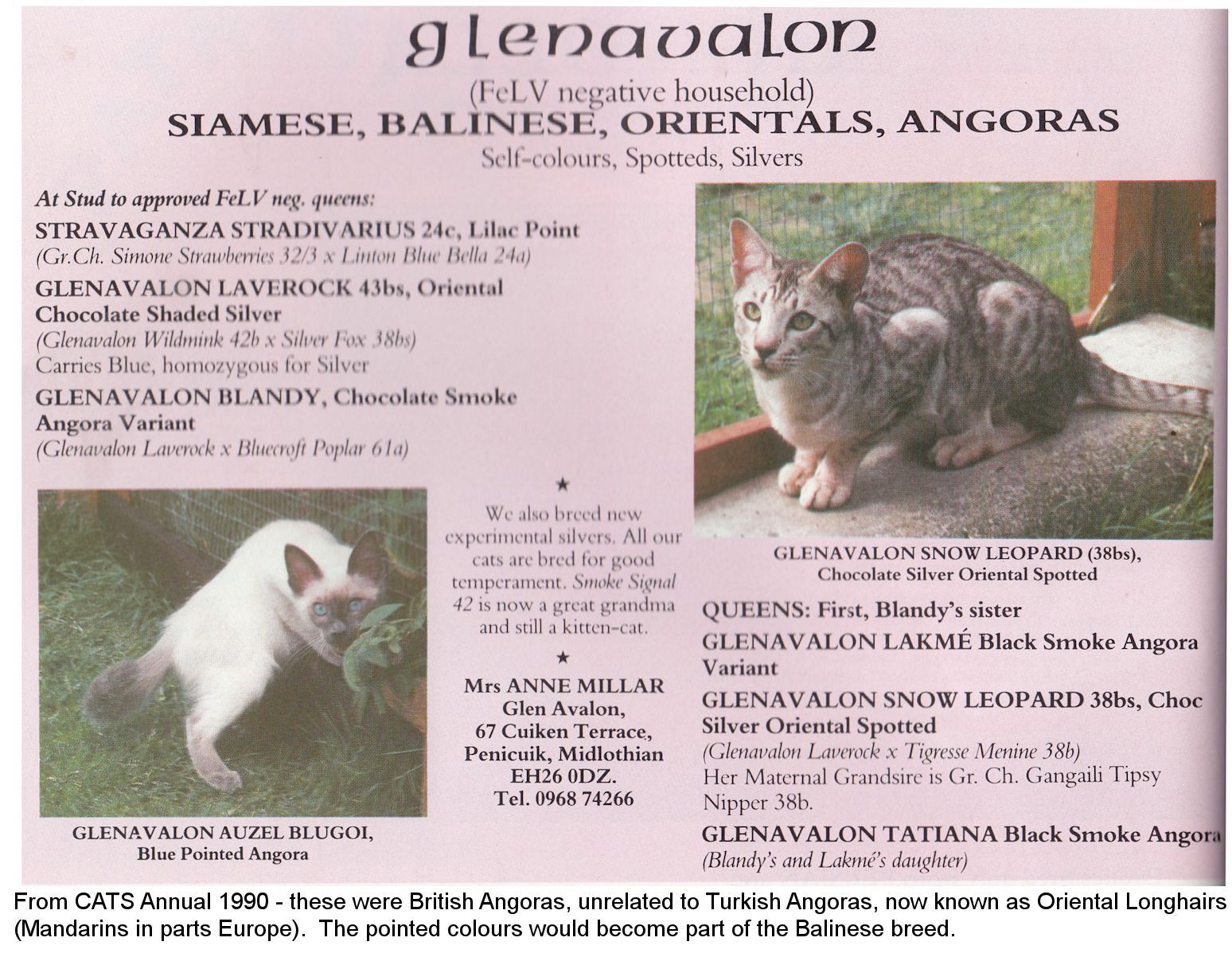
While the American registries debated the matter of colourpointed Orientals (many breeders refusing to view them as Siamese), The New Zealand Cat Fancy, Inc., decided that Siamese and Oriental Shorthairs, regardless of whether they were colourpointed or not, would all compete in one section at NZCF shows. Orientals were originally named 'Self-Siamese'. During the 1977 show season in New Zealand, the Siamese Division's Best Cat was Mrs. J. Dawson's Oriental Chocolate Tortie, Grand Champion Donahill Choco Sequins, while a Red Tabby Oriental and a White Oriental were also in the Top Ten Cats.
In 1978, Britain's GCCF granted Breed No. 38 to the Oriental Spotted Tabby Shorthair and Breed No. 37 to the Foreign Black (Ebony Oriental Shorthair in the USA). In the GCCF system, rooted in the late 1800s, each colour was treated as a separate breed. Notable UK black Oriental Shorthairs included Flayre Midnight, Scintilla Ebony Enchantress, Solitaire Midnight Cowboy and Cymbeline Anouk. In Australia, the Self Blacks were the first Oriental Shorthairs. Their breeding programme began in 1957 and they received full recognition in 1964 under the name Susuki.
ORIENTAL LONGHAIRS
The equivalent of Oriental Longhair type cats had already existed in Britain under the name "Angora" since the 1970s. They aimed to recreate the look of the Turkish cats that had been supplanted by the Persian. It was first recognised by the GCCF in 1977 and was bred in a wide range of colours. Its voice was similar to that of the Siamese and it was more fecund than the Turkish Angora. The "British Angora" was a Foreign Longhair in all but name and had Provisional status since 1998. In 2002 Britain's GCCF renamed this breed Oriental Longhairs, to remove confusion. In FIFe they were also known as "Javanese" and some other organisations used the breed name "Mandarin." When faster communication made the cat fancying world a smaller place, there was an effort to harmonise breed names. Crossing Oriental Longhairs to Siamese to ensure consistent conformation has tended to reduce the longhair coat so that many now look like shorthairs with plumy tails and a bit of a neck ruff. Perhaps there is room for a truly longhaired foreign cat to be developed!
In the USA, TICA accepted Oriental Longhairs for registration in 1984, and for full championship status in 1985. In TICA, the Oriental Longhair and Oriental Shorthair compete as separate breeds. CFA accepted Oriental Longhairs for provisional status in 1994 and championship status in 1995. In CFA, Oriental Longhair and Oriental Shorthair compete as the same breed, "Oriental". The first CFA Oriental Longhair grand champion was Talisyn's Seance of Suntea (lilac male) in October of 1995. In 1996, CFA excluded Siamese variants (longhair gene carriers) from being shown, but Oriental Shorthair variants (carrying longhair) can still be shown. In 1996, more Oriental Longhairs became grand champions: Balinan Steely Dan (blue ticked tabby) and Clowntown Gavin of Kittenrun (blue silver ticked tabby), and an Oriental Shorthair variant (longhair carrier) Rakiscats Roitiro (lilac mackerel tabby) also became a grand champion. Oriental Longhairs were accepted for ACFA championship in 1996.
The first European-born Oriental Longhair grand champion in CFA was a lilac silver spotted tabby boy from Liechtenstein, NekoNoShiro Dicaprio Leonardo (lilac silver spotted tabby) in 2001. Leonardo came from a cattery in Liechtenstein. The lilac lynx point Balinese stud, NekoNoShiro Excalibur was a major influence. Unfortunately, a few breeders in the USA excessively inbred their cats for looks, with little regard for health problems. Though praised by judges some of these prizewinning cats had hereditary heart issues. The Balinese-Javanese (Javanese = red series Balinese in this context) division in CFA began with Balimoor Puff n' Stuff (red point foundation stud, born 1978), Alonale Willo-the-Wisp (blue tabby point, born 1978), and their daughter, a seal tabby-tortie point Siamese (longhaired) variant Balimoor Willo-Two (born 1979).
ANGELA SAYER'S ORIENTAL APRICOTS
THE CAT THAT COULDN'T BE by Pauline Thompson
(This article appeared in CATS Magazine (USA) in 1971.)
1,830 BEAUTIFUL CATS competed at Britain's National Cat Show in December, 1968, and one who attracted a goodly share of admiration and attention from judges, breeders and spectators in the big Olympia show hall, London, was Solitaire Aquamarine, the "cat that couldn't be." Many geneticists in England, before seeing for themselves this foreign-type, dilute Tabby-Tortie and White cat, owned by Mrs. Angela Sayer, tend to question her very existence. The reason? Solitaire Aquamarine has incredible eyes of the deepest sapphire blue! Blue eye colour goes hand-in-glove with the colour restriction to points factor in the Siamese cat and, until Aquamarine's birth on July 21, 1968, the popular conception was that, with the exception of the Self White cat where blue eye colour is usually associated with deafness, it would be impossible to get blue eye colour on a cat coloured all over. Mrs. Sayer, whose long-term goal is to produce a blue-eyed pale apricot (hot cream) cat of extreme foreign type, self-coloured or with deeper spots but no bars, was never completely convinced of this.

Solitaire Aquamarine is one of a litter of six unusual kittens resulting from a mating between Solitaire Topaz, a striking, brightly patched, yellow-eyed Tortie and White Foreign Shorthair, and Viva Dandylynx, a Blue Lynx-point Siamese with vivid blue eyes. Topaz was the only female and only non-Siamese in the litter of a Lilac-point Siamese queen and Self Red, half-Siamese stud. Prior to this litter, Topaz had had two others from matings with a Lilac-point Siamese. Included in each litter was one kitten with pale, watery-blue and white coat dotted with blue and cream spots about an inch in diameter. The first of these two kittens, Solitaire Rosette, got out of the cattery by accident one day and was killed by a car; the eyes on the second kitten turned from blue to gold at eight weeks. Geneticists, whom Mrs. Sayer consulted, considered that Rosette would have proved sterile as they attributed her blue eye colour to a breakdown on a chromosome!
Aquamarine's littermates included another Blue Tortie and White with pale blue eyes and no tabby bars; one female with large black ocelot markings on a pale brown background, white legs, chest and shoulders, and deep gold eyes; a green-eyed male with Blue Tabby markings on a silver-grey background; and a little male Tortoiseshell with distinct blue and cream patches on white. Aquamarine herself is basically a white cat with blue tabby and apricot markings around her eyes and on her body in clear patches. Her muzzle and legs are pure white, ears blue and apricot and her tail mainly blue with rings and apricot flecks. This unusual cat competed at Olympia in six classes for Any Other Variety Cats or Kittens, Male or Female, taking a Second and a Reserve in two of them. Comments from those seeing Aquamarine for the first time ranged from: "It must be a Siamese look at those blue eyes!" to: "It can't be a Siamese; look at her coat pattern!"
Even the judges' after the show comments published in "Fur and Feather" reflected the controversy surrounding this cat who, according to current beliefs, couldn't possibly exist. Mrs. Iris Hancox wrote: "....Mrs. Sayer's Solitaire Aquamarine, a Tortie-Tabby, I think; she had blue and cream stripes on her face and tail, and blue and cream patches on her ears and back. Her eyes are a wonderful shade of blue but I think she is an Any Other Colour Dilution Siamese." Mrs. K. Vickers commented: "I could perhaps be forgiven for thinking that this kitten was a Blue Cream Tortie Point Sia-mese with rather a mingled coat; a very attractive exhibit."
The "cat that couldn't be" will soon be mated in Solitaire's next phase of its program to produce the first Apricot Foreign. Mrs. Sayer expects the initial standard for this breed to call for green eye colour as she feels this will be comparatively easy to create; however, the ultimate in feline beauty, she believes, will be the Apricot Foreign with sparkling, deep blue eyes.Solitaire Tagetes, Red-point son of a Lilac-point sire and Chocolate Cream Tortie queen, will sire Aquamarine's first litter which is expected to consist of a variety of exotic offspring. Mrs. Sayer sees the possibility of Self Blue, Self Lilac, Self Apricot, Blue point, Lilac-point, Chocolate-point, Redpoint, Cream-point, and all dilutions of Lynx-point and Tortie-point Siamese. There is also the possibility of some of the foregoing with white which would be discarded from the breeding program. All exotic kittens resulting from Solitaire's experiments in search of the Apricot Foreign are altered before going outside of the cattery's control; the Siamese offspring are never used to breed further Siamese.
Mrs. Sayer, who has succeeded in breeding her first dream cat, a 20th century replica of the ancient Egyptian cat*, now has Solitaire Aquamarine, the cat that couldn't be, as living proof that longtime conceptions can sometimes turn out to be fallacies. This, in turn, might encourage other breeders to pursue their own "impossible dream." [* In the 1970's Angela Sayer mated Havanas and other non-pointed Oriental Shorthairs to tabby-point Siamese resulting in spotted and classic tabby cats which were initially referred to as 'Egyptian Maus' because of their similarity to cats depicted in ancient Egyptian art. Her Maus were not related to the Egyptian Mau cat breed. Messybeast.]
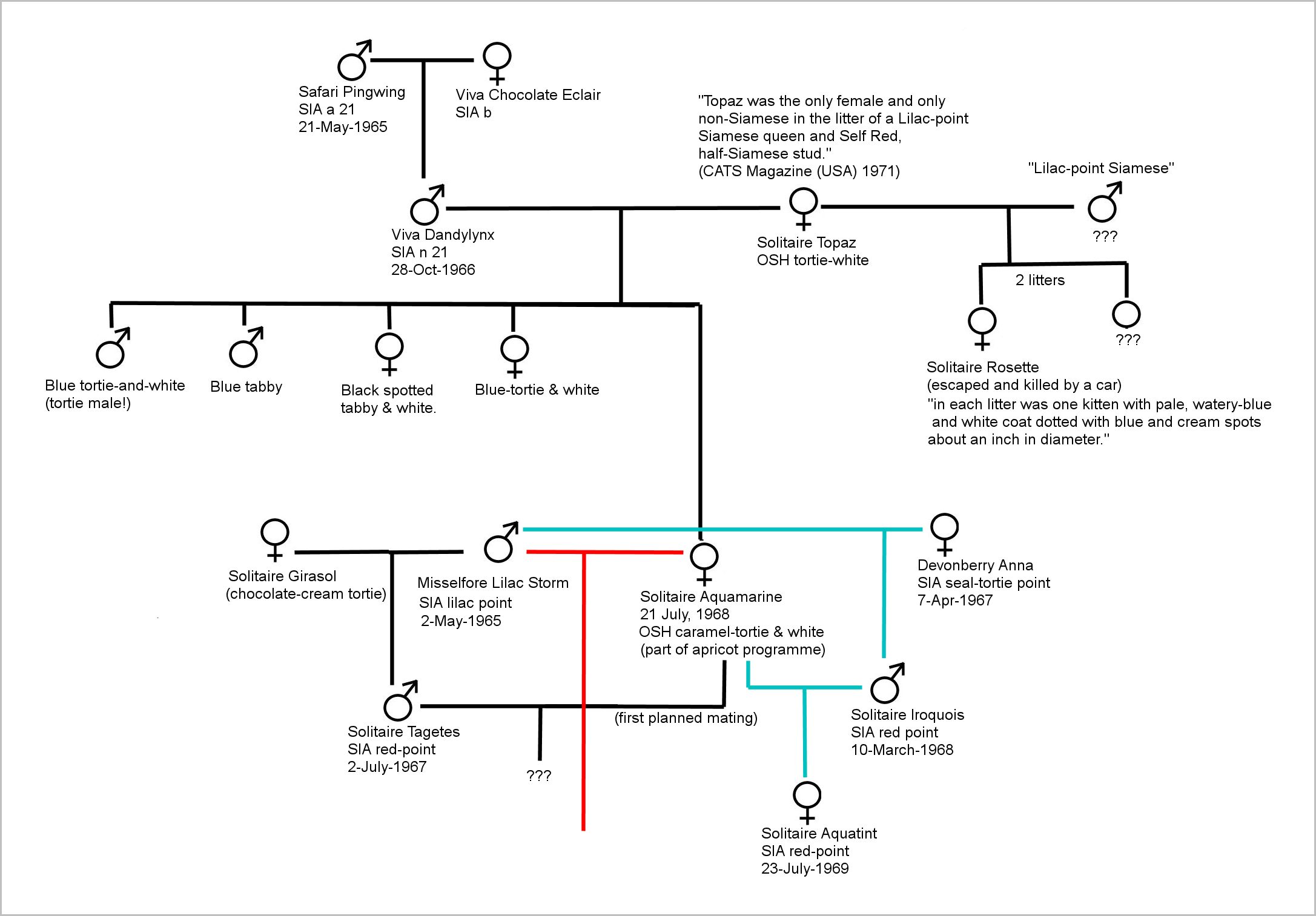
PAT TURNER'S ORIENTAL PASTELS
The breeding program for Oriental Pastels began in Britain in 1970 when a mating between a Chinchilla (black silver) and a Siamese produced two kittens with tipped coats. In today's terminology these were chocolate tipped Oriental Shorthairs. The kittens were backcrossed to Siamese to improve body type and to ensure that colours other than black and chocolate were introduced into the pedigrees. Scintilla Chocolate Froste, a Chocolate Pastel was born in 1974; he was a fourth generation Oriental and was the first Oriental Pastel at public stud. Scintilla Chocolate Froste sired his first litter of Pastel kittens in 1976 out of Scintilla Lilac Dusting, a Lilac Pastel. Since like-to-like breedings are desirable to preserve the pastel coat, back-crossing to Siamese is not frequent and type on the Pastels is not as extreme as on other Oriental colors, Sometimes Pastel kittens are difficult to identify as the pastelling is not always evident until maturity.
Pastels were put on exhibition for the first time at the Siamese Cat Club Show, 1973. They were part of a special exhibit of Orientals by Mrs. Law and Miss Patricia Turner.
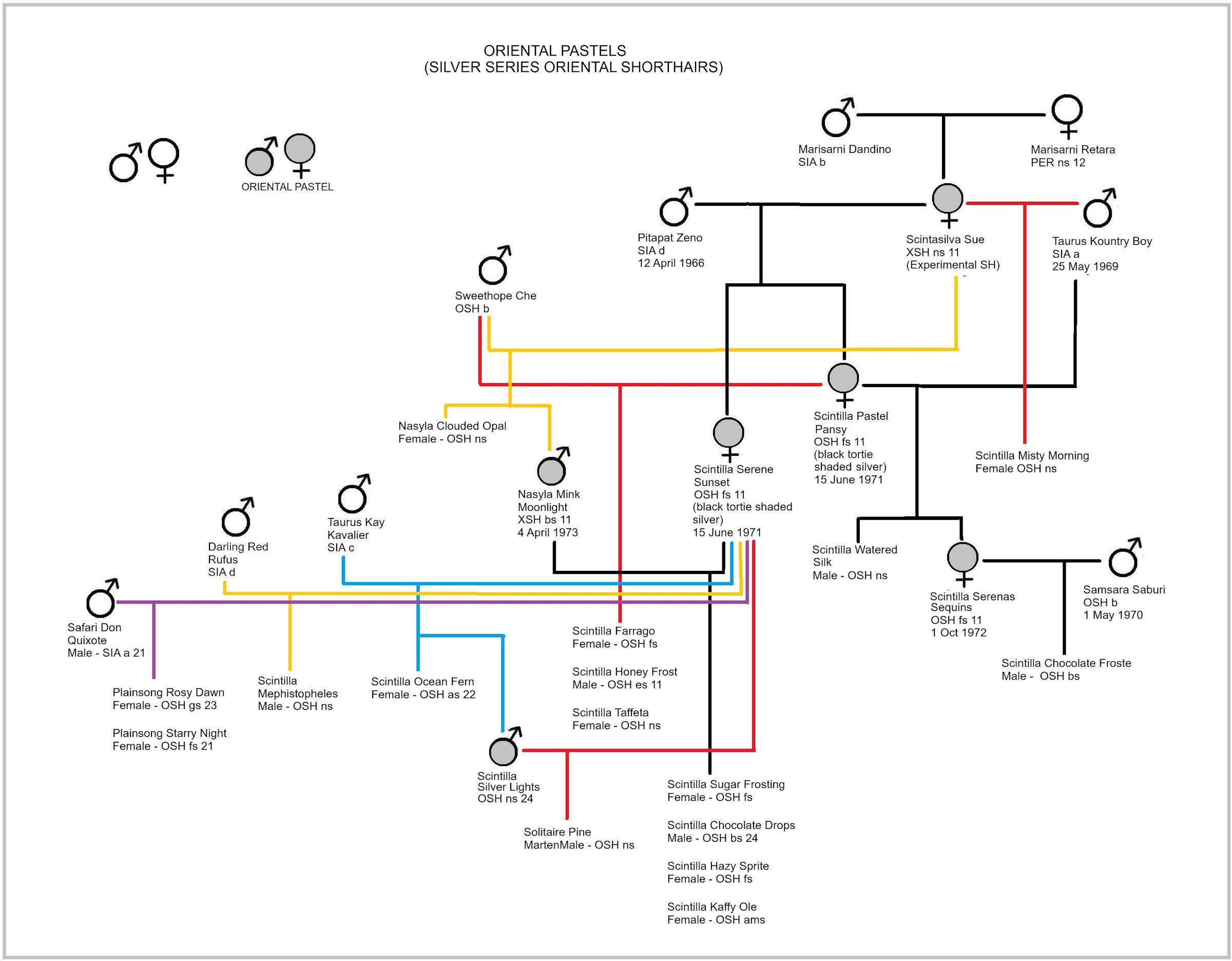
PAT TURNER'S MOCK ALBINOS
Pat Turner, in her series on genetics in Cat World (International) wrote in the November-December 1974 issue about something she called "Mock Albino." It was once believed that inhibitor (silver) and colourpoint (temperature sensitive albinism) were alleles of the same gene. Turner was fond of inventing terms. What she was describing was cream-silver point - some of her cats must have carried dilution as her mock albinos ranged from orange-pointed to having barely perceptible yellowish points. Although she believed that breeding these "mock albinos" to each other would result in normally pointed kittens, the outcome would have been a mix of cream-silver point and cream-point (if the parents were heterozygous for silver/inhibitor). Her work eventually led to the silver series Orientals which she termed "Pastels."
"Another interesting effect produced by combination of colour genes is the "mock albino" sometimes produced when genes for Siamese, sex-linked orange and inhibitor are combined. This "mock albino" is white with blue eyes and perhaps a slight yellowy tinge to the coat and tail. Those produced have been neutered but there is no doubt that if they were bred like-to-like they would produce some normally-pointed kittens. The combination of Siamese and inhibitor in other colours produces the Siamese with smoked points: it is the addition of sex-linked orange that produces the albino effect. However such cats are not common and the effect is variable with by far the greatest number having white bodies and orange tails. So far, none of them have reached maturity and attempts are being made to place them in homes as neutered pets where the colour development can be observed over the years. It may be that the mock albino will eventually develop coloured points."
THE FOREIGN WHITE
(This is based on an article published in 1974, detailing the early years) The Foreign White was developed by a small band of British breeders led by Patricia Turner and Dr Moran and his daughter, Lyn, in New Zealand. The first breeding programme started by Miss Turner (the Derbyshire programme) was abandoned because of the high percentage of deaf kittens bred. Although there were a number of crosses, by 1974, all exhibition Foreign Whites were descended from five crosses between Siamese and white shorthaired cats Surrey Programme (Mr Stirling-Webb), Irish programme (Miss Flack); Lancashire programme; Norfolk programme (Mrs Davis); and a more recent County Antrim Programme. Foreign White programmes began later in the USA.

Patricia Turner planned the Foreign White breeding project in Great Britain and estimated that it would be a ten-year project starting in 1962. Along the way, this project confirmed that the blue eye normally seen in white cats were different to those in the Siamese and that the latter could be combined with the golden-eyed white crosses to give another type of blue. The varieties of blue eye were given the following names:
WHITE-BLUE: blue eye found in the white Persian and white Shorthair i.e. associated with the dominant white gene.
SIAMESE-BLUE: blue eye found in the Siamese and associated with the colourpoint gene.
COMBINATION-BLUE: blue eye produced when the white-blue (from dominant white) and Siamese blue were combined.
TURNER-BLUE: blue eye produced when the golden eye white and Siamese blue were bred together.
Odd eyes (one blue and one golden) were due to dominant white, but there were also odd eyes that were different types of blue due to mixing Siamese blue and dominant, part of the COMBINATION-BLUE expression.
This classification was unwieldy because different expressions of blue could hide for several generations. The breeding project developed into a wider study of white coat, blue eyes and deafness genetics involving white cats all over the world.
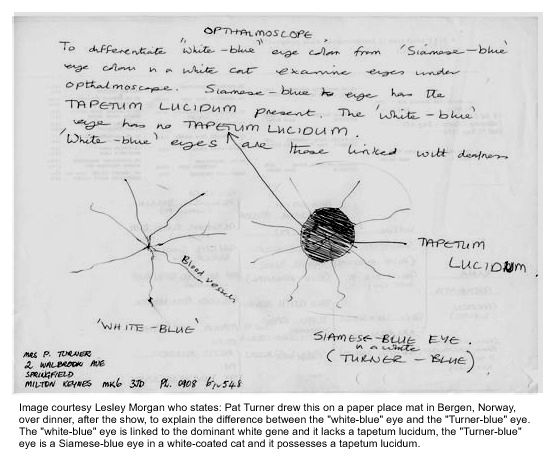
The pioneer breeders found that about 50% of the kittens bred were coloured because only one copy of the dominant white gene was needed for the white coat and this masked other colours. Some of these coloured offspring became very successful. notably Miss Turner's Sanulla Champion Copper Beech was a Havana bred from a Foreign White and founded a dynasty of Solitaire Havanas. Champion Scintilla Golden Legend was a Red Point Siamese bred from a Foreign White.
Another problems was deafness, now known to be linked to dominant white. The first breeding programme had been abandoned because of the high percentage of deaf kittens bred. Two deaf males were kept for test matings with queens of the Lancashire and Norfolk breeding programmes which she also had under way. Only those females whose progeny proved free of deafness were used for breeding. Other unwanted characteristics were persistent: odd eye colour, head smudges and too long coats. The head smudges proved that some of the solid white cats were homozygous for white spotting and were not dominant white. The coat length was linked to recessive genes.
In 1968 breeding data on Foreign Whites was correlated for a report in a specialist journal on. However, it was a time of problems among breeders. Mr Stirling-Webb had died leaving only one Foreign White female to continue the Surrey programme; Mrs Dunnill had taken over but very few kittens had been bred. Miss Flack (Irish programme) was becoming increasingly disabled by arthritis and was unable to exhibit. Miss Turner, who had housed and exhibited some of Miss Flack's Monach cats as well as her own Scintilla cats, required several operations and mobility problems and was unable to attend shows.
EBONYS. With reference to Mrs. Dagmar Thies' article in "Cats" last issue [May/June 1971] about a New Colour-type of Foreign Shorthair [EBONY. A New Colour-type of the Foreign Shorthair. by Dagmar Thies], I have been breeding a European Foreign type cat for 10 years now. Having been at school in Austria I grew to like the European type with dark green eyes and long bones and thick short fur. In England people have bred too much Longhaired Persian into their Shorthaired breeds and have lost the true green eye it is part yellowish green or orange now. Arctic Chumui was a Foreign White Cat not Siamese. She was found in the Pool of London by the R.S.P.C.A. and she was quite unlike any British Cat. She had long bones, large ears, slant eyes; beautiful thick soft lustrous shiny White fur and green eyes. When crossed with British tabbies she never threw a tabby kitten. She was a Self colour with no coat pattern. We crossed her with Russian Blues only, and I got jet black kittens and white kittens. . . . In Thailand they value the green eyed cats more than the blue eyed cat, which is common there. The Black or White cat from North East of Laos is the traditional Chinese cat, bred for two thousand years in China. Mao is Chinese for Cat Mao, or Mi-ao. Black is closely associated with White to get Blue Black and green eyes. If associated with brown you do not get the true blue black or the green eye. - Frances MacLeod, 70 William Street, New Marston, Oxford.
BICOLOURED ORIENTALS AND THE MODERN SEYCHELLOIS
Note: This article uses internationally accepted colour terms. CFA uses ebony (black), blue, chestnut (chocolate), lavender (lilac) and calls any other point colour Siamese a Colorpoint Shorthair, while any colourpointed cat that has Orientals within its 3 generation pedigree is called a "Pointed Oriental" and not Siamese (similar applies to CFA Balinese/Javanese).
In the 1960s, the Foreign White breed began and this was when Oriental type bicolours and Oriental tortie-and-whites appeared. The breeding plan for Foreign Whites involved eradicating any pattern other than Seal Point Siamese, so the white marked kittens were neutered as pets. Another source of Oriental-type bicolours came from outcrossing the Cornish Rex to Orientals to expand the Cornish Rex gene pool. No serious attempt were made to breed Orientals with white markings as a result of either breeding programme. In this article, for brevity, "bicolour" includes tortie-and-whites.
Experimental breeding of bicoloured Orientals in Britain began in the 1970s and 1980s and included Pat Turner's "Seychellois" breeding program. Turner (Scintilla cattery,Milton Keynes) wanted to create an Oriental conformation breed with a high-white bicolour pattern. To introduce the white spotting gene, she crossed Siamese to Persians and then backcrossed the offspring to Siamese/Oriental cats to restore the Oriental conformation. Turner's cats had the Scintilla prefix and she carefully recorded her experimental breeding, but few of her Seychellois pedigrees appear on breed databases. The detailed story of Turner's Seychellois appears later in this article.
The modern Oriental Bicolours began in 1979 when Lindajean Grillo (Ciara Cattery, USA) mated Siamese cats to Bicolour American Shorthairs to introduce the white spotting gene. The best Bicolour offspring were mated back to Siamese or Orientals to restore the Oriental conformation. Her Oriental Bicolours (longhair and shorthair) gained TICA recognition in 1983 and the first champion was Ciara Quite-N-Oreo. CFA Oriental breeders were initially opposed to introducing white spotting into the Siamese/Balinese/Oriental breed group.
The family tree is best viewed on a separate tab using your browser's magnifier.
The history of the modern Seychellois Shorthair (SYS) and Seychellois Longhair (SYL), "Seychellois, new sibling breeds in category IV)," was written by Trine Piltoft and published in "Danish Siamese and Oriental Ring," page 2705, Vol. 13. Another account appeared in Cat World, December 1992, in the article "The Bi-Colour and Tri-Colour Orientals."
Two prominent breeders were Catherine Bastide-Costes (France) and Yvonne Kleyn (Netherlands). Catherine Bastide-Coste became interested after seeing a black bicolour named Ciara's Tuxedo Junction in the late 1980s. In partnership with Daniel Noureaux in 1988 she acquired a tortoiseshell-and-white female Oriental named Ciara's Quelles Couleurs (aka Quelly) from Lindajean Grillo. Quelly was a 5th generation cat from Grillo's breeding programme. Ciara's Quelles Couleurs was bred to El Shaklan Chetane Souarda (black silver spotted) resulting in a tortie bicolour pointed Siamese, and a tortie-tabby-and-white Oriental named El Shaklan Esmija. El Shaklan Esmija had a rather poor oriental type, but had a lot of white and very distinct black and red patches. El Shaklan Esmija was mated to Felides Vivres Purr-Fume who had excellent type and who did not carry colourpoint. Three of the 5 kittens were bicolour and one particularly good female was named Felides Vivres Dazzling-Danielle-D in honour of Daniel Noureaux. Danielle-D was later mated to Felides Vivres PurrKins, resulting in Felides Vivres Purrsonality .
Meanwhile, Dutch breeder, Yvonne Kleyn, became interested in bicolour Orientals after seeing a tortie-and-white Oriental at a 1987 cat show in Switzerland. This had been bred by Mirte Voigt and was a 3rd generation cat from outcrossing to an Oriental-looking bicolour domestic cat Voigt had brought back from Morocco (according to Voigt, there were some charming, slender cats, mostly red and white, around the hotel and she finally caught one that resembled an Oriental). Six months after seeing Voigt's cat, Kleyn acquired a tortie-and-white Oriental female named Erphe von Ghadaia who was mated to Felides Vivres Purr-Fume, a black-smoke Oriental chosen because he did not carry the colourpoint gene. This resulted in 5 kittens, including a red bicolour named Felides Vivres Purrkins.
There are two cats named Felides Vivres Purr-Fume in online databases, both black-smoke, but only one is Dutch-bred and didn't transmit colourpoint. The one used by Kleyn was a son of Procol Harum Zazu Bobatoon x Felides Vivres Puss Pone, born 17 November 1988.
Kleyn acquired El Shaklan Esmija from Bastide-Coste and mated her to Felides Vivres Purrkins. The litter included a black bicolour female that was mated back to Felides Vivres Purrkins. Two kittens from this mating went to Bastide-Coste. The mating of El Shaklan Esmija x Felides Vivres Purrkins combined Kleyn's Moroccan breeding line with Bastide-Coste's French breeding line.
Kleyn also crossed a lilac spotted female Oriental (without colourpointing gene) to an imported black bicolour American Cornish Rex named May-iks Chiandre resulting in two bicolour kittens. One was a blue bicolour female named Felides Vivres Puss-Tel, which was later mated to Procul Harums Pretzel Logic, resulting in 4 bicolour kittens, including a blue bicolour female named Felides Vivres WhisPurr. Whis-Purr was mated to Purrkins, thus combining the French, Moroccan and American bloodlines. Kleyn also added two cats from the MiJonJons cattery in the USA; a chocolate bicolour female named MiJonJons Mixed Blessing, and a black smoke male named MiJonJons Double or Nothing. One offspring of those two cats was the black bicolour female Felides Vivres Purr-Allel, whose offspring sired by Felitan Flying Dutchman are behind the majority of the bicolour Orientals, bicolour-point Siamese/Balinese and Seychellois breeding lines today.
Siamese breeders all over Europe were opposed to introducing white spotting into their breed because they had worked diligently to eliminate white lockets and white toes from the breed. Although white lockets are caused by a recessive gene, they were concerned that this fault could be hidden by the dominant white spotting gene if this was accepted as a new pattern in the Siamese/Balinese. Should the new pattern be called "Siamese/Balinese with white" or "Masked Oriental with white"? Neither name was acceptable and ultimately Mundikat (NL) and FIFe recognised the cats as Seychellois Longhair (SYL) and Seychellois Shorthair (SYS) with EMS codes 01, 02, 03 for the degree of white spotting (van, harlequin, bicolour respectively). Masked offspring where one or both parents was "with white" could be registered as Siamese or Balinese but the pedigree must be marked for 9 generations to show that there was "with white" ancestry. This allowed breeders to decide whether to not to use such cats in a Siamese or Balinese breeding programme.
The family tree is best viewed on a separate tab using your browser's magnifier.
PATRICIA TURNER'S "SEYCHELLOIS."
Experimental breeding of bicoloured Orientals occurred during the 1970s and 1980s in the UK, including Pat Turner's "Seychellois" breeding program. She supposedly chose the name Seychellois after reading about cats living on the Seychelles islands; these were predominantly white with a van or Seychelles pattern of markings. Turner aimed to create a breed that combined the refined Oriental conformation with a bicolour pointed pattern. To introduce the white spotting gene, she crossed Siamese to Persians and then backcrossed the offspring to Siamese/Oriental cats to get back to the Oriental conformation. Most organisations viewed these as a colour variety of the Siamese/Balinese group (Oriental Bicolours or Bicolour-point Siamese/Balinese), but FiFe recognised the Seychellois Shorthair and Seychellois Longhair as breeds in 2005, and the FIFe standard of points correspond to the Siamese and Balinese apart from the pattern.
There are two versions of the story behind Pat Turner's Seychellois breed. The official version was that in 1980, she had 2 tortie-and-white Persians that were to be foundation cats for a new breed inspired by Professor Paul Jaffe, who had studied cats in the Seychelles. Turner had not been to the Seychelles herself. The name came from the coat pattern:
Pat Turner's cats had the Scintilla prefix and she carefully recorded her experimental breeding, but few of her Seychellois pedigrees have made it onto modern public cat breed databases.
In the late 1970s, Turner had supposedly read about the studies of these genes and decided to recreate and investigate this pattern. The two Persians she used were her own Snowdrop Gentle Pedilase and Julie Smith's Dovetrees Tarantella, and the foundation males were Siamese males named Scintilla Pastelle Royale and Ch. Scintilla Caramellian of Jamais. As the generations progressed, Turner's Seychelles-patterned cats became closer to the Oriental type and had the blue eyes of the Siamese. These original Seychellois (unlike the modern FIFe Seychellois) had a very high degree of white. According to an article in Cat World (Sept 1988) these had been under development since 1983 but never exhibited. The UK's Cat Association agreed the breed standard in 1988. Because the breed was only at its 3rd generation, provision was made for eye colour other than blue and lower grades of white spotting while the conformation was being improved.
The more truthful version is that Turner got the white spotting gene from breeding a bicolour Persian to a Siamese. In 1984, Pat Turner helped with the re-homing of the entire breeding stock of a nearby Persian breeder. Among those cats were two Persian tortie-and-white "breakers" a term then used for Harlequin and Van pattern Persians. Turner found the two cats so attractive that she re-homed one to Julie Smith (Dovetrees cattery) and kept the other herself. Both of them were mated to Siamese and both produced several large all white marked litters. Pat Turner decided to continue with offspring from her Persian x Siamese mating, and to challenge the strict EMS rules - she designed the pattern to be a high degree of white - a little more white than 02 (harlequin) but less than 01 (van) so that the pattern didn't fit neatly into either category; she created "neuvieme," "huitieme," and "septieme" for her intermediate patterns! At least that was the impression Ole Amstrup got from conversations with Turner. Early on, masked cats with less white than 02 were even called "Seychellois variants." Turner apparently admitted that the story about the cats in the Seychelles having a special pattern was pure invention!
Pat Turner decided to continue with offspring from this mating, and to challenge the strict EMS rules - she designed the pattern to be a high degree of white - a little more white than 02 (harlequin) but less than 01 (van) so that the pattern didn't fit neatly into either category; she created "neuvieme," "huitieme," and "septieme" for her intermediate patterns! At least that was the impression Ole Amstrup got from conversations with Turner. Early on, masked cats with less white than 02 were even called "Seychellois variants."
They were exhibited in England in 1988 and accepted by the Cat Association as a provisional breed without championship status. The first Seychelles-patterned cats in the programme were Scintilla Felicite, Scintilla Amirante, Scintilla Victoria and Scintilla Therese. Scintilla Felicite and Scintilla Victoria were the first of the new breed to be exhibited. In 1989 the Seychellois Cat Society was formed with a founder membership of Derek and Pauline Parsons (Shalimar cattery), Maureen Trompetto (Lincret cattery), John Mais (Jamais cattery), Shirley Mizon (Zelstone cattery) and Patricia Turner (Scintilla). Emphasis was placed on breeding back to Siamese to improve type rather than on breeding large numbers of cats eligible for the show bench; this also produced many Seychellois variants.

Turner eventually admitted that the story about the cats in the Seychelles having a special pattern was pure invention. Ole Amstrup "inherited" Pat Turner's Seychellois breeding programme when she decided to stop, and he and Elsebeth bred her Seychellois for several years, only stopping stop when FIFe ruled that masked cats could not be mated to whites. Before that ruling, he had exported some of those Seychellois cats to the Netherlands, and some of the long-haired bicolour Orientals that were presented to FIFe in 2003, when bicolour Orientals were approved, were descendants of Amstrup's (and therefore Turner's) Seychellois. It was logical to continue using the Seychellois name when recognising the "with white" Oriental/Siamese/Balinese.
Turner's Seychellois cats were also the start of the Bi-Colour and Tri-Colour Orientals of the 1990s. Eve Martin (Kent, England) and Pat Turner formed the "Parti-Colour Oriental Cat Association." Later, at a restaurant in Central Park, New York, Turner met Lindajean Grillo. Turner, a former textile designer, noticed that Grillo's jacket was the same pattern and material as the tablecloth where Turner and her party were sitting and the two got to talking. The conversation soon turned to cats and it turned out that Grillo was working on a Foreign White breeding programme that duplicated Turner's work 20 years earlier. Grillo had also bred bicolours, but unlike Turner she had was also developing them and seeking recognition for "and whites." Turner and Grillo later exchanged breeding records, news, and even kittens.
A year after that restaurant meeting, Turner was judging in the Netherlands and encountered Yvonne Kleyn's bicolour and harlequin Orientals. Ideally, the British, Dutch, French and American breeders would have exchanged breeding stock, but Turner had had a bad experience with Britain's 6-month quarantine so she began an all-British breeding programme using the founder cats from her Seychellois breeding programme. The initial plan was to register the new Oriental patterns with both the GCCF and the Cat Association of Britain, but this could have led to disciplinary action from the GCCF so Turner worked with the Cat Association which later (and conveniently) became the British member of FIFe. In 1991 Turner's "and white" Orientals went to Ole and Elsebet Amstrup in Denmark to form part of the modern Seychellois breeding programme.
DEVELOPMENT OF "FOREIGNS" IN AUSTRALIA AND NEW ZEALAND
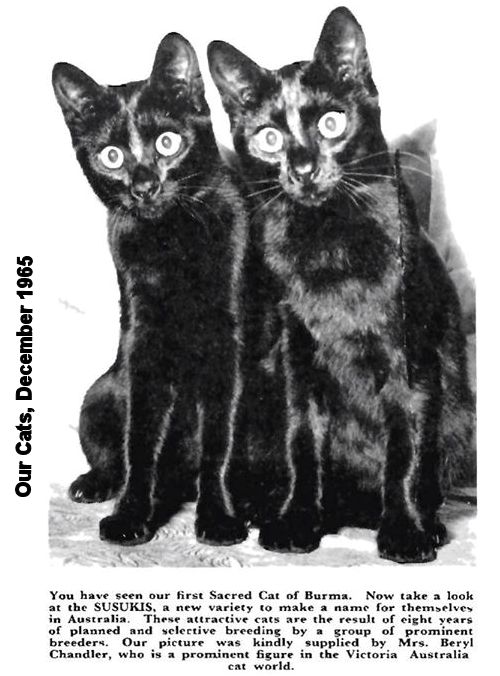
Another early foreign shorthair was the Susuki developed in Australia in 1957. The experimental breed was exhibited during the 1960s. One of the earliest mentions of Susukis appears to be this news item from The Age, Monday March 13, 1961 (Melbourne, Australia): " Mr Douglas Greening, of Box Hill North, has been devoting a great deal of time to the Susukis for three years and the latest news is that, under the description "experimental breed" which, Mr Greening says, is far less offensive than "hybrids," the word used to describe them until now they will be exhibited for the first time at the Croydon agricultural show on March 25. The Susukis are the fruits (through three generations) of the marriage of Pluto of Arden, a seal point Siamese, and a white domestic alley cat, who had a touch of Persian in her ancestry. The fruits have taken two forms both will look, in shape, like Siamese and have Siamese blue eyes, but one will be black all over and the other grey all over. They don't look quite like that yet; they may be described as being half-way there, and Mr Greening thinks that another three generations may bring success."
Susukis, owned by Mrs Van der Spek (a cat breed judge) were exhibited in Tasmania in the mid 1960s. Susukis used the same mix as the more successful Havana Brown/Havana Lilac, but the breeders' original objective of a solid black cat with blue eyes was a genetic impossibility because the blue eye colour was inextricably linked to the colourpoint pattern of the foundation sire. Mrs Chandler, a noted figure in the Australian cat fancy, always referred to the Susukis as having "hazel" eyes. The foundation sire, Pluto of Arden (a Seal-Point Siamese) was noted for his poor temperament. The founding mother appears to have been a blue-eyed white that carried the recessive long-hair gene. In 1964, Beryl Chandler reported that "Black [Foreign Shorthairs] (now called black Oriental) were shown in considerable numbers."
According to Our Cats, January 1965 in the overseas news report: "In Victoria there is a completely new type of black shorthair cat with hazel eyes called Susukis. These I found to be a mixture of Siamese and black domestic. We in New Zealand have seen the progeny of mismatings between Siamese and the ordinary British Shorthair cat. Some beautiful half-breeds have resulted, with the Siamese-type body, oriental blue eyes and a black shiny shorthair coat. But we had not thought of them as a new breed." In Victoria, several breeders were keen on producing hazel-eyed Susukis. The May 1965 issue of Our Cats added "Eight years of careful, planned and selective breeding was undertaken to produce [Susukis]. They are indeed attractive with their almost fluid sleekness and grace." The breeders involved were Hiljoy Cattery (Mrs Van der Spek and Miss Holding), Suzeraine Cattery (Mrs Carmichael, Miss Thomas, Mrs Buck, Beryl Chandler and Mr Hartnell) and Rothesay Cattery (Mrs Matheson). Mr Greening, who bred the original stock, had retired.
Some of the influential breeders of Foreign and Oriental cats in Australia and New Zealand were Zoe Jermyn (Sarayan prefix), Hilda Jeremiah, Lorna Pratt, Gabrielle Kaufmann, Una Meany and Twink McCabe. McCabe worked with cinnamon Foreigns. Gabrielle Kaufmann's experimental breeding of Foreign-type cats dates back to the 1940s. Una Meany (Sydney, Australia) had at least 3 generations of her own experimental "Chestnut Brown Foreigns" (Lindfield prefix) in 1964. In the 1960's, Foreign whites were being developed by Zoe Jermyn in Victoria, New South Wales, Australia, and she also did some interesting work with red series Siamese. Much later on, when some of the Sarayan lines met up again in other people's breeding programmes, some throwbacks to other colours turned up as a result of recessive genes carried down through the generation. Cats from some of these long established Australian lines were sent to Europe towards the end of the 20th century.
(With thanks to Lesley Morgan and Liz Claxton for information from Australia and New Zealand.)
EXPORTATION OF "FOREIGNS" TO NORTH AMERICA AND RECHRISTENING TO "ORIENTAL"
The British-bred oriental (albeit not yet having that name) and Foreign cats were exported to America in the early 1970s. They were crossed with American Shorthairs to produce even more colours. Many American Shorthairs at that had unknown backgrounds and some were imported Foreign Shorthairs. The American Shorthair "Black Jack," who was registered as unknown background, was a Foreign Black (US: Ebony Oriental Shorthair) bred from Solitaire Pine Marten (Ebony Smoke Oriental Shorthair) and Solitaire Tyfyny (Lilac Pt Siamese). Black Jack was exported to the USA as an American Shorthair in spite of his Siamese/Foreign/Oriental ancestry! Although the cats are retrospectively described as Oriental Shorthair on modern databases, this was not necessarily the breed name when they were bred.
During the late 1960s and early 1970s, solid colour cats with foreign conformation were advertised under their colour name, not yet having a breed name. They were Chestnut Shorthairs, Lavender Shorthairs etc. It would take a while longer for these to be pulled together under a single breed name coined by the CFA.
In the USA, the "Oriental Shorthair" was accepted for CFA championship status in 1977. It was developed to explore the possible combinations of colour and pattern combined with a Siamese-type body. Self (solid), tabby, spotted, ticked, bicolour, tortie, tortie-and-white and silvers are all possible in various combinations.
While British "Angoras" had existed since the late 1970s, it wasn't until the 1980s that the first cross-breeding between an Oriental Shorthair and a Balinese cat took place in the USA. This created the Oriental Longhair (Javanese or Mandarin in Europe), which had the same physique as an Oriental Shorthair, but with mid-to-long fur. In 1995 the Oriental Longhair it was recognised by CFA.
A little more about the British exports to North America. Kay Hanvey (an American cat judge visiting the UK) obtained some of her first Oriental cats through Angela Sayer (or Sayer's friends) in Britain, including her original stud Chocind Seti of Chipmunk (Chocolate/Chestnut Classic Tabby born 12-Jun-1983) from Brenda Aylward, an early classic tabby with an EXP registration number. The breeder of one of Seti's parents was trying to breed longhaired foreign conformation cats i.e the British "Angora. " Seti's grandfather was Rian Chocolate Ripple (also Chocolate/Chestnut Classic Tabby, born 18-Apr-1980 ) and was one of the first classic tabby oriental shorthair cats. At that time, breeders called the patterned cats "Oriental" and the self colour cats "Foreign." Sayer held a lot of the history of this breed group, particularly the self colours and of her contribution to developing the lynx point Siamese and later the tabby Oriental Shorthairs. This was just before Sayer split from GCCF and formed The Cat Association.
(With thanks to Kay Hanvey for additional information.)
WHAT'S THE DIFFERENCE?
International trade in breeding stock means that the modern Oriental cats are very consistent in type around the world. Some countries have slightly different breed standards, for example recognising different subsets of the colour range or requiring less extreme-conformation. In parts of Europe, all blue-eyed white cats for breeding require a hearing test and there are legal restrictions on extreme typing (of all cat breeds).
THE BRITISH "ANGORA" (ORIENTAL LONGHAIRS IN THE UK)
Angora Breed Club (flyer inside 1997 catalogue for the Siamese Cat Association 21st championship show.)
The ANGORA is the longhaired version of the Oriental just as the Balinese is the longhaired version of the Siamese. Alternatively, the Angora could be considered to be the full coloured equivalent of the Balinese in the same way as the Oriental is the full coloured equivalent of the Siamese. In the eighteen-nineties some Longhaired cats were referred to as "Angoras"; these were supposedly distinguished from the Persians by having a more angular head, larger ears and a longer, silkier, uneven coat. By the early nineteen-hundreds the Angora was no longer recognised as a separate breed and some authors of the day doubted that it ever had been distinct. The "Angora" was then forgotten for many years and the only accepted Longhaired breed in Britain was the Persian. Other longhaired breeds were introduced: Turkish Vans were imported and then Birmans. Balinese (longhaired Siamese) appeared on the show bench in 1975 and in 1981 the first Somalis (longhaired Abyssinians) were born in this country. Maine Coons were given Preliminary recognition in 1988 and now have Championship status. Norwegian Forest Cats were recognised in 1989, Ragdolls in March 1990 and finally the Tiffanies (longhaired Burmese and Asians) in September 1990. Unfortunately the Angoras have lagged behind although they have been recognised almost as long as the Balinese and far longer than the Somalis.
In the late 60's and early 70's, Kernow Gerza and Kernow Koptos, offspring of a mating between a Sorrel Abyssinian and a Seal Point Siamese, were used by Maureen Silson in her breeding programme. In 1971, from the brother-sister mating of these cats, Maureen bred Southview Pavane, the first Oriental Cinnamon. However, these two had inherited more than the light brown (cinnamon) gene from their Abyssinian sire - they had also inherited the gene for longhair and passed this on to several of their kittens. Although not the first to be produced, the first Southview longhair to cause excitement was Trappist, a "longhaired Havana" who was born in 1973. Trappist, known to his friends as "Cuckoo", was used for breeding and was on exhibition at the~197& Supreme-Show. This was the start of today's Angoras - the Oriental Longhairs - who are not related to the Angoras of the last century or to the Turkish Angoras which are recognised by some Fancies overseas. Many of the immediate descendants of Kernow Gerza and Kernow Koptos proved to carry the longhair gene and are behind the majority of today's Angoras. In order to maintain the breed, Angoras were mated out, first to Siamese and Orientals and then to Balinese as well when these became available and these matings are still the basis of the Angora breeding programme. There are now more Angora breeders and some new lines have been produced by mating Orientals to Balinese and breeding the resulting full-coloured, short-coated variants back to Balinese. The Angora breed is now increasing in numbers and in the interest they are causing and the ANGORA BREED CLUB was formed to encourage the breeding and showing of Angoras under GCCF Rules; we hope to help them on their way, eventually, to the Championship status they deserve.
We have, so far, drawn up a revised Standard of Points for Angoras and a Registration Policy, both of which have been approved by the GCCF. We offer rosettes to Members' Angoras for each Merit awarded, plus special rosettes for cats who gain four qualifying Merits, and hope eventually to gain Affiliation to the GCCF so that we can offer Club classes for our Angoras. We can also supply Standards of Points for the individual colours for use at Shows.